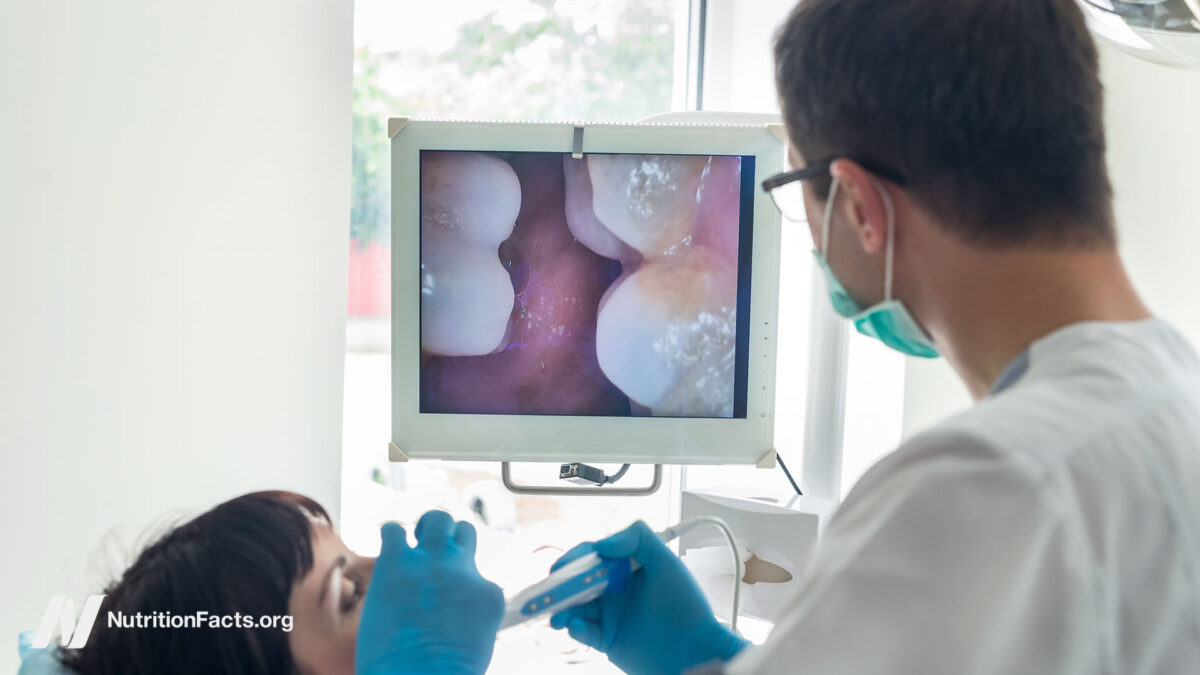If sugar consumption is considered to be the one and only cause of cavities, can we have any sugar? How much is too much?
Dental cavities may be humanity’s most prevalent disease, affecting 35 percent of the global population. The average number of decayed, missing, and filled teeth has been estimated at more than two by the age of 12. In the United States, the oral health of our elderly may also be in a state of decay, with one in four missing all of their teeth. “In terms of economic costs,” it is estimated that $100 billion is spent on dental diseases due to sugar consumption.
As I discuss in my video How to Stop Tooth Decay, sugar consumption is considered to be the one and only cause of cavities. It is often referred to as a multifactorial condition, with other factors including bacteria, plaque, saliva, brushing, and flossing. However, those factors appear to have only mitigating influences. All of those other factors simply modify the speed by which sugar causes cavities. “Without sugars, the chain of causation is broken, so the disease does not occur.”
“Numerous studies from decades ago showed that in countries where sugar consumption was very low, dental caries [cavities] was almost non-existent,” and “new analyses show that the life-long burden of caries increases as sugar intakes increase from 0%E [zero]…The most comprehensive national data are from…Japan…before, during and after World War II,” where the incidence of cavities tracked per capita sugar intake as it dropped from about 8 percent of calories down to just 0.1 percent, which is less than a teaspoon a week, before rebounding up to about 14 percent. Such studies show that cavities continued to occur even when sugar intake comprised only 2 to 3 percent of caloric intake. Given that more extensive disease in adults doesn’t appear to manifest if sugar intakes are limited to less than 3 percent of caloric intake, a public health goal to limit sugar intake to below 3 percent has been recommended. This led to the suggestion that traffic-light food labels be used to mark anything above 2.5 percent added sugars as “high.” That would make even comparatively low-sugar breakfast cereals such as Cheerios “red-light” foods.
The recommended 3 percent cap on total daily intake of added sugars wouldn’t even allow for young children to have a single average serving of any of the top ten breakfast cereals most heavily advertised to them, which you can see below and at 2:21 in my video. Obviously, soda is off the table. One can of soda has nearly two days’ worth of added sugar.

The American Academy of Pediatric Dentistry adopted the more pragmatic goal of recommending sugar intake stay below 5 percent for children and adolescents, matching the World Health Organization’s conditional recommendations for both children and adults. That’s about where added sugar consumption dropped in Iraq when they were under sanctions, and cavity rates were cut in half within just a few years. Of course, the sanctions may have cut other things, too, like the lifespan of children, though that was apparently fake news—a consequence of the “government of Iraq cleverly manipulating survey data to fool the international community.”
If we were really interested in minimizing disease, the ideal goal would be to drop the intake of free sugars (meaning added sugars) to zero. These are not the sugars naturally found in breast milk or the intrinsic sugars in fruits. When it comes to the intake of added sugars, there does not seem to be a “threshold for sugars below which there are no adverse effects.” An exponential increase in cavity rates can begin for sugar intakes starting as low as 1 percent.
A Kellogg’s-funded researcher agreed that we might be able to get rid of cavities if there was no sugar in the diet, but suggested that “this ideal is impractical.” The “dictatorial use of foods ‘friendly to the teeth’…might promote a philosophy of dietary celibacy…[that] would not be applicable or acceptable to all individuals.”
“Instead of recommending draconian reductions in the amount of sugars intake,” the sugar industry responded that “attention would be better focused on…fluoride toothpaste.”
That’s the perfect metaphor for medicine’s approach to lifestyle diseases in general. Why treat the cause when you can just treat the consequences? Why eat more healthfully to prevent and treat heart disease when we have all of these statins and stents?
Not all sugars are created equal. To explore this topic, see my videos Flashback Friday: If Fructose Is Bad, What About Fruit? and Flashback Friday How Much Fruit Is Too Much?.
To gain a sense of how powerful the sugar industry is, check out my video Big Sugar Takes on the World Health Organization.
For more on dental and oral health, see the related videos below.
